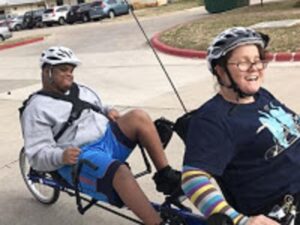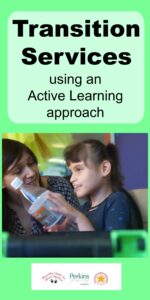Transition Services
As students get older, it is increasingly important to begin to focus on the skills that they will need for adult life. This should include skills that they need for everyday life, such as movement, communication, and self-care (toileting, dressing, bathing, eating, etc.), as well as other functional skills. Sometimes introducing materials that can be used in a functional context may be helpful. For example, if a learner is interested in surfaces that are bumpy, exploring a vacuum cleaner hose may introduce a functional element.
Transition Planning

In addition, the team should begin meeting by the time a student is 14 years old to discuss future plans. Where will the individual live? How will he or she spend the day? What gives them joy? How much one-on-one support is available to them and how much time will he or she be required to entertain themselves?
This also means having discussions with all members of the team to be sure that priorities are addressed and that the goals are the same for everyone.
What are the family’s preferences? The learner’s preferences? The school’s preferences? We need to think outside the box when planning for most learners with significant multiple disabilities, as they will not be following typical career paths or live independently.
How Do Current Activities Relate to Future Goals?
The underlying question for all older students should be how current activities relate to future goals. When you get a student who is over the age of 14, everything you do needs to be focused on adult life and quality of life (both physical and mental health). This includes making choices, being actively engaged in one’s surroundings (rather than a passive observer), and developing meaningful recreational interests. It also includes hygiene and fashion, as well as self-care and independent living activities.
With recreation and leisure activities, it may mean, for example, helping them to create a collection of items they’re interested in like rocks, shoes, bowling pins, or beads. Self-care activities may include grooming routines with an electric razor or beauty routines such as facials. One young woman we know enjoyed going to a salon and getting her nails done regularly. Independent living activities could include cooking, vacuuming, or doing the dishes. For some individuals, it might be helping to prepare favorite foods or participating in volunteer activities in the community.
Recycling Activity
Description: Example of learning activities for older learners.
Customized Employment or Volunteering in the Community

Customized employment may incorporate highly motivating activities or materials that are reinforcing to the individual. We know of one young man who LOVED all candy, especially chocolate. He learned to help service vending machines in neighborhood businesses and was able to earn candy as a reward when he finished his work.
A young woman in the Philippines with visual impairments and multiple disabilities loves to mix any and all kinds of liquids together. Her parents have helped her set up her own business with a line of beauty and cleaning products.
What activities might be appropriate for older learners?
Each of these activities can be made as simple or complex as is appropriate for an individual student.
- Flower delivery
- Putting together herb sachets & potpourris
- Mixing spices (mulled cider, chili, Indian curries, Italian seasonings)
- Making tea bags
- Mixing essential oils
- Doing dishes — rinsing them if student loves water — pass to someone to put in dishwasher
- Watering plants
- Making popcorn and packaging it
- Making dog biscuits and selling them to a vet or pet store.
- Going to an animal shelter, pet store, farm or ranch to help care for animals (grooming, feeding, cleaning)
- Visiting a pet store or farm to feed or groom animals
- Rolling coins
- Following a beauty/spa routine with makeup — fingernails, manicure in water bath
- Packaging materials
- Filling a vending machine
Thinking About the Future
It is important to begin early when planning for the future. Once your child leaves school, where will he or she go? How will he or she spend the day? How can you help to build an Active Learning approach into adult life?
Parent Sarah Lundgren shares her plan for her son’s life after the age of 22.
Download a PDF article –Dean’s Life After 22
Webinar Focusing on Older Learners
Downloads:
A TVI and classroom teacher describes how she serves her secondary-level students who are visually and multiply impaired using Lilli Nielsen’s Active Learning approach along with other strategies.
See Classroom Centers and Activities for Older Students for examples for teenage learners (13-22 years of age).


